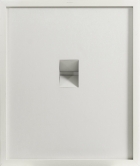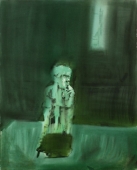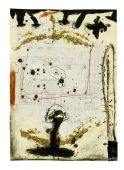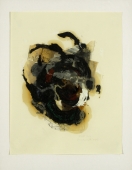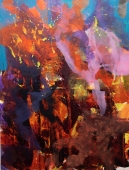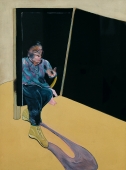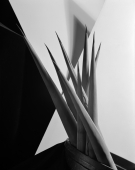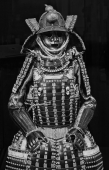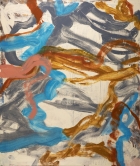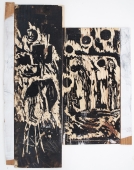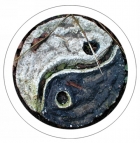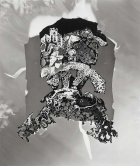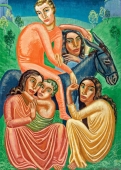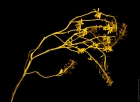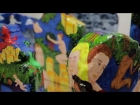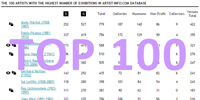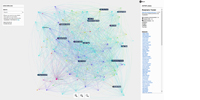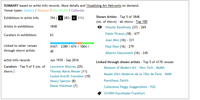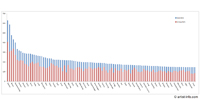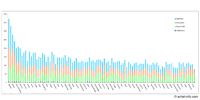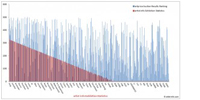
Artist | Donald Judd (1928 - 1994)
Alias: Donald Judd [Don Judd]
https://www.artist-info.com/artist/Donald-Judd
Biography
Biography
born in 1928, died in 1994
About the work (english / deutsch)
About the work (english / deutsch)
In General
In 1980 the Museum für Moderne Kunst acquired not only a set of 80 works by a variety of international artists dating from the Sixties und Seventies but also two sculptures by the American artist Donald Judd: they had all been part of the collection formerly owned by Karl Ströher, the Darmstadt industrial magnate.
Judd, whose works are made up of simple geometrical or stereometrical figures or bodies, is one of the main representatives of Minimal Art, a movement that evolved in the Sixties. His sculptures tend to engender a concrete spatial setting by delimiting a volume of air. Judd evidently wishes to convey to us a sense above all of the difference between the objective, concrete form and our subjective experience of that form when perceiving it.
Eight Modular Unit V-Channel Piece
In the case of the Eight Modular Unit V-Channel Piece (1967) Judd chose to construct the form out of serial elements - quite in keeping with the trend among the Minimalists - arranging these to generate a clear and regular symmetrical structure. These component parts are worked and coloured perfectly, with the result that they demonstrate Judd's interest in giving a basic sculptural idea as objective a material form as possible, enabling the viewer to experience subjectively the manifold appearances of the object. By electing not to give the work a title and instead opting for a precise technical description of the sculpture's formal structure, Judd points up the fact that the sculpture is intended to be bereft of all individual expression. Moreover, there are clear pointers to the components' industrial origin, to the fact that these parts can be reproduced by technological means, and thus that they can essentially be repeated at will. Judd constructs his sculpture out of identical rectangular frames that lie on their longer side; their form is accentuated by the fact that the sides of each consist of a V-shaped channel, whereby the "V" points inwards. For all the similarity between the frames, this channel sets them off from one another, for it creates an interplay of surfaces that are alternately lit or shadowed. In this way Judd points to the importance of that the surface properties of the material and the colours have in his sculpture, because these two qualities are effected both by the lightfalling on the sculpture at a given moment and by the particular position of the observer. The eight parts of the artwork are placed parallel to one another in such a way that the space betwee them is always the same in width as the components themselves are. In other words, using a serial group of modular elements Judd creates a sculpture which, by virtue of the underlying principle which determines the order of the parts, lays claim to a space of its own. The order involved entails no formal hierarchy and is thus highly objective. Given that the artwork's structure is intrinsically regular and each part can be replaced by one of the others, the sculpture provides no scope for an interpretation in terms of its depicting general structural theorems. Judd confirms this when he says: "A shape, a volume, a color, a surface is something itself. It shouldn't be concealed as part of a fairly different whole. The shapes and materials shouldn't be altered by their context. One or four boxes in a row, any single thing or such a series, is local order, just an arrangement, barely order at all. The series is mine, someone's, and clearly not some larger order."
Within the coordinates of the exhibition room and when placed one behind the other, the framing elements define a specific three-dimensional volume und demonstrate the multi-referential relationship between sculptural und non-sculptural space. When walking around the sculpture, the observer sees a series of external limits created by the eight parts, whereby these blend with one another and yet also tend to break apart: the spaces between the parts allow a view of the interior of the sculpture so that "space" can be experienced here as a temporal value. In adition, the sculpture includes other optical elements that change. Depending on the observer's vantage point, the artwork appears to be a cube with two open sides seen in distorted perspective (the slanted surfaces merge to form one apparently uniform surface) or a lattice-like open und yet nevertheless uniform structure that constantly changes in terms of outline, proportions, mass and scale.
Although in other versions of the sculpture Judd elected not to use paint, here it is allocated a specific function. Like the component parts it has been removed from its original industrial context where it would have been used as car paint and serves instead as an expressive element, uniting all the components with one another as a whole and setting them off clearly from their surroundings.
Judd's piece is a completely autonomous, concrete spatial structure that refers only to itself and its own intrinsic laws. The work and its contents reveal themselves only to the eye of the perceiver.
German text by Rolf Lauter / Translation by Jeremy Gaines
(Extract - Full printed version available in the Museum)
MMK - Museum für Moderne Kunst, Frankfurt am Main
Allgemeines
Im Jahr 1980 hat das Museum für Moderne Kunst neben einem Konvolut von 80 Werken internationaler Künstler der 60er und 70er Jahre auch zwei Plastiken des Amerikaners Donald Judd aus der ehemaligen Sammlung des Darmstädter Industriellen Karl Ströher erworben. Judd, dessen Arbeiten aus einfachen, geometrischen bzw. stereometrischen Figuren oder Körpern gebildet sind, ist einer der Hauptvertreter der in den 60er Jahren aufkommenden Tendenz der Minimal Art. Seine Plastiken formulieren meist konkrete Raumsituationen aus ein- und ausgegrenzten Luftvolumina und wollen dem Betrachter vor allem den Unterschied zwischen der objektiven, konkreten Form und dem subjektiven Formerlebnis während des Wahrnehrnungsprozesses vor Augen führen.
Eight Modular Unit V-Channel Piece
Bei seiner Plastik Eight Modular Unit V-Channel Piece (1967) verwandte Judd - wie viele andere Minimal-Künstler auch - serielle Formelemente, die er zu einem klar und regelmäßig gegliederten, symmetrischen Komplex ordnete. Die perfekte Bearbeitung und Kolorierung der Elemente demonstrieren sein Interesse an einer möglichst objektivierbaren Materialisierung einer bildnerischen Grundidee, durch die der Betrachter die von subjektiver Erfahrung geprägte Erscheinungsvielfalt eines Objekts erleben kann. Bereits der Verzicht auf einen inhaltlichen Werktitel, der durch eine präzise Beschreibung des formalen Bestandes ersetzt wurde, weist auf eine Abgrenzung gegenüber jeglichem individuellen Ausdruck hin. Darüber hinaus lassen sich deutliche Hinweise auf die industrielle Herkunft der Werkbestandteile, ihre technische Reproduzierbarkeit und damit eine denkbare unbegrenzte Wiederholbarkeit erkennen. Judd konstruierte seine Plastik aus identischen, querrechteckigen Rahmenelementen, die durch einen umlaufenden, von außen nach innen zugespitzten, V-förmigen Kanal akzentuiert werden. Durch diesen Kanal erhalten die Elemente eine bestimmte, über ihre Gleichförmigkeit hinausweisende Differenzierung, die in einem Wechsel von beleuchteten und verschatteten Flächenpartien besteht. Dadurch weist der Künstler auf die Bedeutung der Oberflächenwirkungen des Materials und der Farben für seine Plastiken hin, die von der jeweiligen Lichtsituation und den sich ständig verändernden Betrachterpositionen abhängen. Die acht Rahmenelemente stehen in der Weise parallel nebeneinander, daß zwischen ihnen jeweils ein Abstand von einer Elementtiefe bleibt. Aus einer seriellen Gruppe modularer Einheiten setzte Judd eine raumgreifende Plastik zusammen, der ein konsequentes Ordnungssystem zugrunde liegt. Die Ordnung baut auf keiner formalen Hierarchie auf und vereint damit einen hohen Objektivitätsgrad in sich. Da die Art der Werkstruktur in sich völlig regelmäßig ist und jedes Teil durch ein beliebiges anderes ersetzt werden kann, erlaubt die Plastik keine Deutung in Richtung auf allgemeine strukturale Zusammenhänge. Eine Aussage Judds bestätigt dies: "Eine Gestalt, ein Raumkörper, eine Farbe, eine Oberfläche sind Dinge an sich. Sie sollten nicht verborgener Teil eines doch recht andersartigen Ganzen sein. Die Gestalten und Materialien sollten nicht durch ihren Kontext verfremdet werden. Ein Kasten oder vier in einer Reihe, irgendein Einzelding oder eine derartige Serie: Das ist räumliche Ordnung - gewiß aber keine 'höhere Ordnung'."
Die hintereinander gestaffelten Rahmenformen definieren innerhalb der Koordinaten eines Ausstellungsraumes ein bestimmtes plastisches Volumen und demonstrieren das beziehungsreiche Wechselspiel von plastischem und außerplastischem Raum. Der Betrachter blickt beim Umschreiten der Plastik abwechselnd auf zum Teil ineinanderfließende, zum Teil aufbrechende äußere Elementbegrenzungen und durch die Zwischenräume in die Plastik hinein, wodurch 'Raum' als zeitbezogener Ausdruckswert erfahrbar wird.
Die Arbeit schließt daneben aber noch weitere optische Veränderungsmomente mit ein. Je nachdem, von wo aus der Museumsbesucher das Werk betrachtet, erscheint ihm dieses als ein auf zwei Seiten offener, perspektivisch verzerrter Kubus - die schräggestellten Flächen fügen sich dabei zu einer einheitlich wirkenden Fläche zusammen -, oder als ein permanent in den Umrissen, Proportionen, der Masse und dem Maßstab variierendes, gitterartig geöffnetes, aber einheitliches Gefüge.
Die Farbe, auf die der Künstler bei anderen Versionen dieser Arbeit verzichtete und die wie die Elemente selbst aus dem industriellen Zusammenhang entnommen ist (es handelt sich um Autolack), übernimmt hier die Funktion eines Ausdrucksträgers, der alle Einzelteile untereinander und zu einer Gesamtheit verbindet und diese wiederum deutlich aus der Umgebung hervorhebt.
Judds Arbeit ist ein absolutes autonomes, konkretes räumliches Gebilde, das allein auf sich selbst und seine Eigengesetzlichkeiten verweist. Allein den sehenden, wahrnehmenden Augen des Betrachters öffnet sich das Werk und sein Inhalt.
Text von Rolf Lauter
(Auszug - Der vollständige Text ist als Informationsblatt beim Museum erhältlich)
MMK - Museum für Moderne Kunst, Frankfurt am Main
 offers / Requests offers / Requests  |
Learn more about this service |
|---|
 Exhibition Announcements Exhibition Announcements  |
About this service |
|---|
 Visualization |
Learn more about this service | ||
|---|---|---|---|
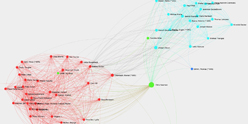
Interested in discovering more of this artist's networks?
3 easy steps: Register, buy a package for a visualization, select the artist.
See examples how visualization looks like for an artist, a curator, or an exhibition place: Gallery, museum, non-profit place, or collector.

Exhibition History

|
SUMMARY based on artist-info records. More details and Visualizing Art Networks on demand. Venue types: Gallery / Museum / Non-Profit / Collector |
||||||||||||
| Exhibitions in artist-info | 397 (S 96/ G 301) |
Did show together with - Top 5 of 2675 artists (no. of shows) - all shows - Top 100
|
||||||||||
| Exhibitions by type | 397: 196 / 118 / 74 / 9 | |||||||||||
| Venues by type | 232: 96 / 77 / 54 / 5 | |||||||||||
| Curators | 130 | |||||||||||
| artist-info records | Oct 1962 - May 2025 | |||||||||||
|
Countries - Top 5 of 19 United States (187) Germany (93) Switzerland (24) United Kingdom (17) Netherlands (11) |
Cities - Top 5 of 86 New York (152) Berlin (19) London (14) Frankfurt am Main (14) Köln (11) |
Venues (no. of shows )
Top 5 of 232
|
||||||||||
Curators (no. of shows)
Top 5 of 130
|

Kosmos Kandinsky - Geometrische Abstraktion im 20. Jahrhundert |
||||||
| Museum Barberini | G | Feb 2025 - May 2025 | Potsdam | (8) | +0 | |
| Barentsen, Sterre (Curator) | +0 | |||||

ZERO, Pop und Minimal - Die 1960er und 1970er Jahre |
||||||
| Von der Heydt-Museum | G | Apr 2022 - Jul 2023 | Wuppertal | (131) | +0 | |
| Bruns, Anika (Curator) | +0 | |||||
| Eickhoff, Beate (Curator) | +0 | |||||

Judd |
||||||
| Museum of Modern Art - MoMA (2/7) | S | Mar 2020 - Jan 2021 | New York | (153) | +0 | |
| Temkin, Ann (Curator) | +0 | |||||

An Unlikely Friendship - John Wesley in conversation with Donald Judd |
||||||
| Alison Jacques Gallery | G | Mar 2019 - May 2019 | London | (71) | +0 | |

L'Aventure de la couleur - Œuvres phares du Centre Pompidou |
||||||
| Centre Pompidou - Metz | G | Feb 2018 - Jul 2019 | Metz | (27) | +0 | |
| Lavigne, Emma (Curator) | +0 | |||||

The Great Graphic Boom |
||||||
| Staatsgalerie Stuttgart | G | Jul 2017 - Nov 2017 | Stuttgart | (68) | +0 | |
| Keep reading |














